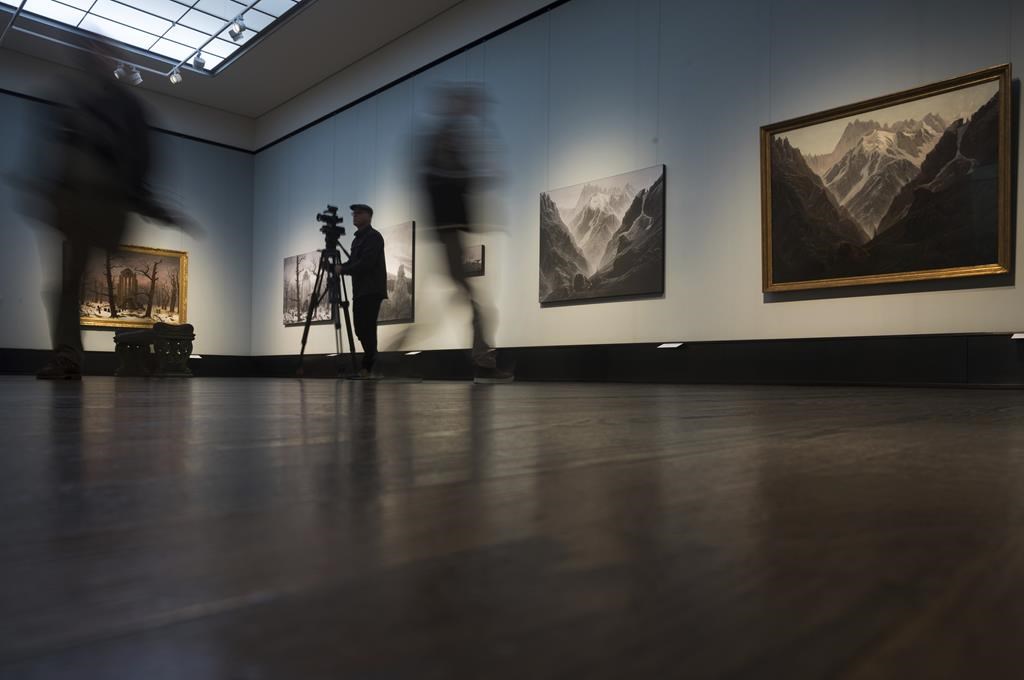BERLIN (AP) — A major show of Caspar David Friedrich’s iconic landscapes that marks the 250th anniversary of his birth is opening in Berlin, where he made his breakthrough and where a 1906 exhibition kicked off an enduring revival of interest in the German Romantic master.
The show at the German capital’s Alte Nationalgalerie, which organizers presented on Wednesday ahead of its opening to the public Friday, includes some of Friedrich’s best-known works.
Among them are the two paintings that brought him to fame in 1810, “Monk by the Sea” — depicting a lone figure against the background of a dark sea and looming sky — and “Abbey among the Oaks.” The works were bought by King Friedrich Wilhelm III of Prussia.
Visitors can also look forward to classics such as the dramatic “The Sea of Ice,” “Chalk Cliffs on Rügen” and “The Watzmann,” depicting one of Germany’s highest peaks. The exhibition brings together 115 paintings and drawings by Friedrich, exploring the progress of his career.
Although the paintings are based on painstaking drawings, some of which are part of the exhibition, they “are not a reflection of nature, but are actually visions on the great philosophical questions of human existence,” museum director Ralph Gleis said.
Gleis described Friedrich as probably the best-known German painter after Albrecht Dürer.
That wasn’t always the case. Friedrich, who was born in Greifswald in northeastern Germany in 1774 and died in 1840, was largely forgotten in the second half of the 19th century. He returned to public attention thanks to a 1906 exhibition at Berlin’s Nationalgalerie celebrating a century of German art, which contained 93 works by Friedrich and celebrated him as a master of light and atmosphere.
The new show leans in part on that exhibition and features 45 of the works the public in Berlin saw more than a century ago.
Friedrich, who painted at the time of the Napoleonic wars in Europe, has been associated with nationalism. That’s reflected directly in at least one painting, “Rocky Valley,” featuring the tomb of Arminius, a figure from Roman times who was revered as a German national hero.
His work is characterized by an “openness to interpretation” that has repeatedly been exploited, Gleis said, noting that the Nazis “tried to pocket Friedrich.”
That made it a little difficult for Friedrich’s work to gain attention after World War II. The English-speaking art world helped revive interest in him as a “universal artist,” Gleis added.
Friedrich “created pictures of longing and hope, but also of doubt,” curator Birgit Verwiebe told a news conference.
The Berlin show is one of three partly overlapping major exhibitions in Germany to mark the 250th anniversary of Friedrich’s birth, with museums in Berlin, Hamburg and Dresden collaborating. The first, in Hamburg, closed at the beginning of this month after attracting huge numbers of visitors. An exhibition in Dresden will open in August.
The German museums will support a later exhibition at the Metropolitan Museum of Art in New York “to share our Friedrich with the world,” Gleis said.
The exhibition at the Alte Nationalgalerie in Berlin’s neoclassical Museum Island complex, titled “Caspar David Friedrich. Infinite Landscapes,” runs from Friday until Aug. 4. The museum has extended its opening times to deal with high anticipated demand.
Geir Moulson, The Associated Press







